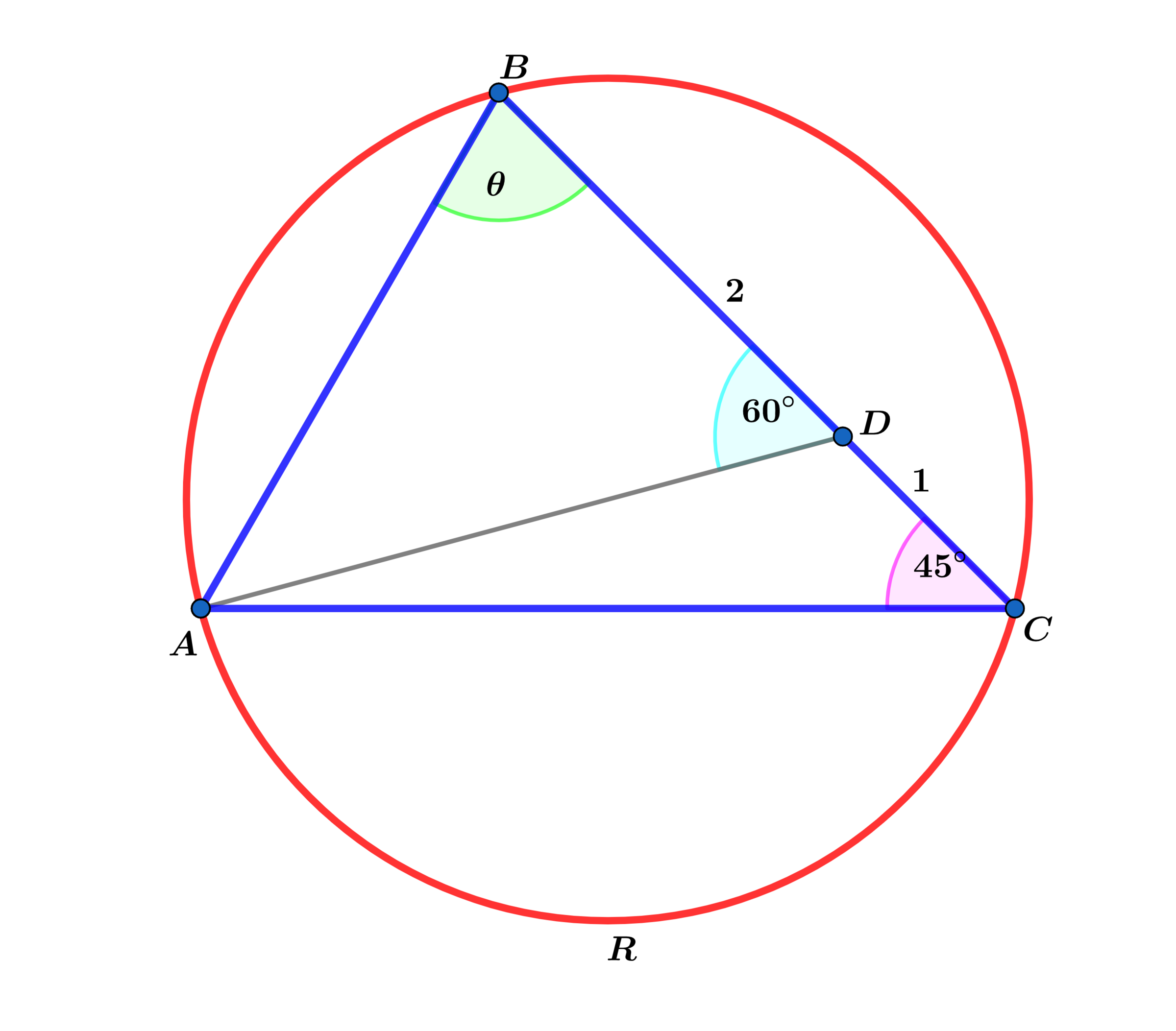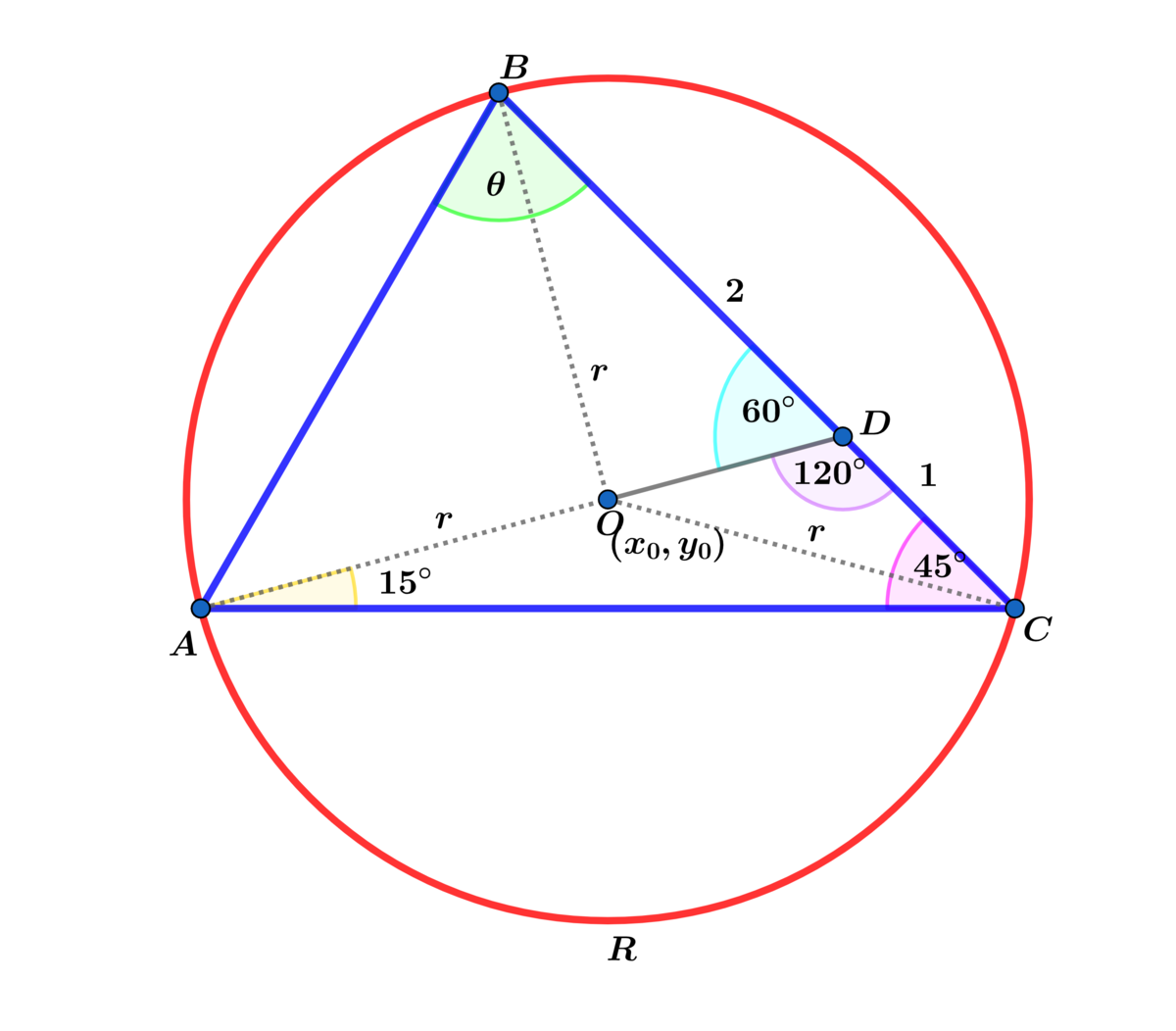Angles, Arcs and Areas!

△ A B C is inscribed in a circle, with m ∠ C = 4 5 ∘ , m ∠ B D A = 6 0 ∘ , D C = 1 and B D = 2 . Let A c be area of the above circle. If A c + m ( A R C ) = b a π , where m ( A R C ) is in radians, and a and b are coprime positive integers, find a + b .
The answer is 29.
This section requires Javascript.
You are seeing this because something didn't load right. We suggest you, (a) try
refreshing the page, (b) enabling javascript if it is disabled on your browser and,
finally, (c)
loading the
non-javascript version of this page
. We're sorry about the hassle.
2 solutions

sin ( 1 5 ∘ ) = sin ( 4 5 ∘ − 3 0 ∘ ) = 2 2 3 − 1
Using the law of sines on △ A D C ⟹
sin ( 4 5 ∘ ) A D = sin ( 1 5 ∘ ) 1 ⟹ A D = 3 − 1 2 = 3 + 1
and
sin ( 1 2 0 ∘ ) A C = sin ( 4 5 ∘ ) 3 + 1 ⟹ A C = 2 3 + 3
Using the law of cosines on
△
A
B
C
with included
∠
C
=
4
5
∘
⟹
A
B
=
6
Using the law of sines on △ A B D ⟹
sin ( 6 0 ∘ ) 6 = sin ( θ ) 3 + 1 ⟹ sin ( θ ) = 2 2 3 + 1 ⟹ θ = 7 5 ∘
⟹ m ( A R C ) = 1 5 0 ∘ and converting to radians ⟹ m ( A R C ) = 6 5 π
To find the area A c of the above circle we use coordinates below with m ∠ B A D = 4 5 ∘ ⟹ m ∠ B A C = 6 0 ∘
A ( 0 , 0 ) , B ( 6 cos ( 6 0 ∘ ) , 6 sin ( 6 0 ∘ ) ) = ( 2 3 , 2 3 ) and C ( 2 3 + 3 , 0 )
( 1 ) x 0 2 + y 0 2 = r 2
( 2 ) x 0 2 − ( 3 + 3 ) 2 x 0 + 6 + 3 3 + y 0 2 = r 2
( 3 ) x 0 2 − 6 x 0 + y 0 2 − 3 2 y 0 + 6 = r 2
Subtracting ( 1 ) from ( 2 ) we obtain x 0 = 4 ( 3 + 3 ) 2
Subtracting ( 1 ) from ( 3 ) we obtain y 0 = 4 ( 3 − 3 ) 2
⟹ r 2 = 3 ⟹ r = 3 ⟹ A c = 3 π ⟹ A c + m ( A R C ) = 6 2 3 π = b a π
⟹ a + b = 2 9 .
By the exterior angle theorem on △ A D C , ∠ D A C = ∠ B D A − ∠ D C A = 6 0 ° − 4 5 ° = 1 5 ° .
By the law of cosines on △ A D C , sin ∠ D C A A D = sin ∠ D A C D C , or sin 4 5 ° A D = sin 1 5 ° 1 , so A D = sin 1 5 ° sin 4 5 ° = 3 + 1 .
Now construct equilateral △ E B D where E is on A D :
Then ∠ B E A = 1 8 0 ° − ∠ B E D = 1 8 0 ° − 6 0 ° = 1 2 0 ° and A E = A D − E D = 3 + 1 − 2 = 3 − 1 .
Since ∠ A E B = ∠ A D C = 1 2 0 ° , and E A B E = D C A D = 3 + 1 , △ B E A ∼ △ A D C by SAS similarity, so ∠ E B A = ∠ D A C = 1 5 ° and ∠ E A B = ∠ D C A = 4 5 ° .
That means ∠ A B C = ∠ E B A + ∠ E B D = 1 5 ° + 6 0 ° = 7 5 ° and ∠ B A C = ∠ E A B + ∠ D A C = 4 5 ° + 1 5 ° = 6 0 ° .
Since ∠ A B C = 7 5 ° , m ( A R C ) = 2 ⋅ 7 5 ° = 1 5 0 ° = 1 8 0 ° 1 5 0 ° π = 6 5 π .
Since △ A B C is circumscribed in the circle, the circle's radius is R = 2 sin ∠ B A C B C = 2 sin 6 0 ° 3 = 3 , and its area is A c = π R 2 = 3 π .
Therefore, A c + m ( A R C ) = 3 π + 6 5 π = 6 2 3 π , which means a = 2 3 , b = 6 , and a + b = 2 9 .